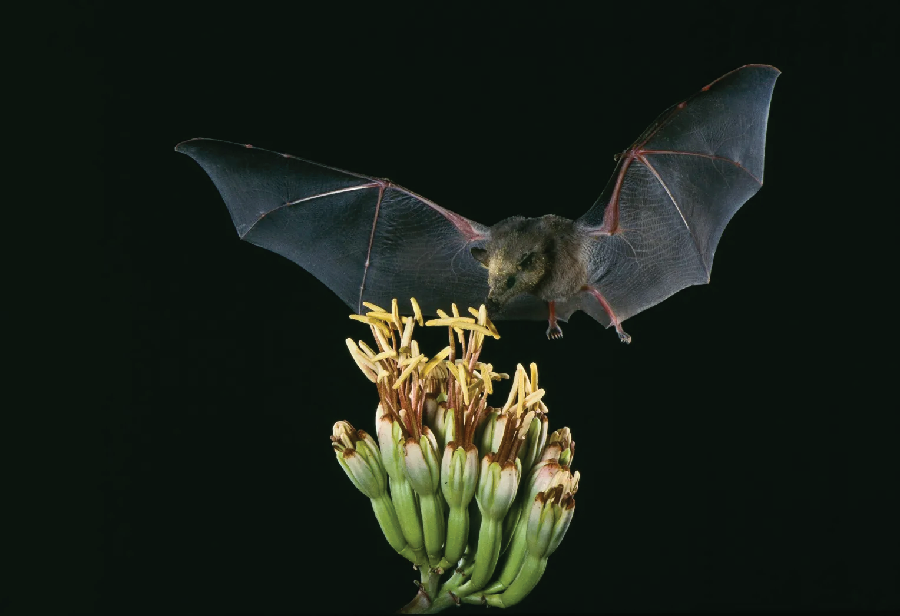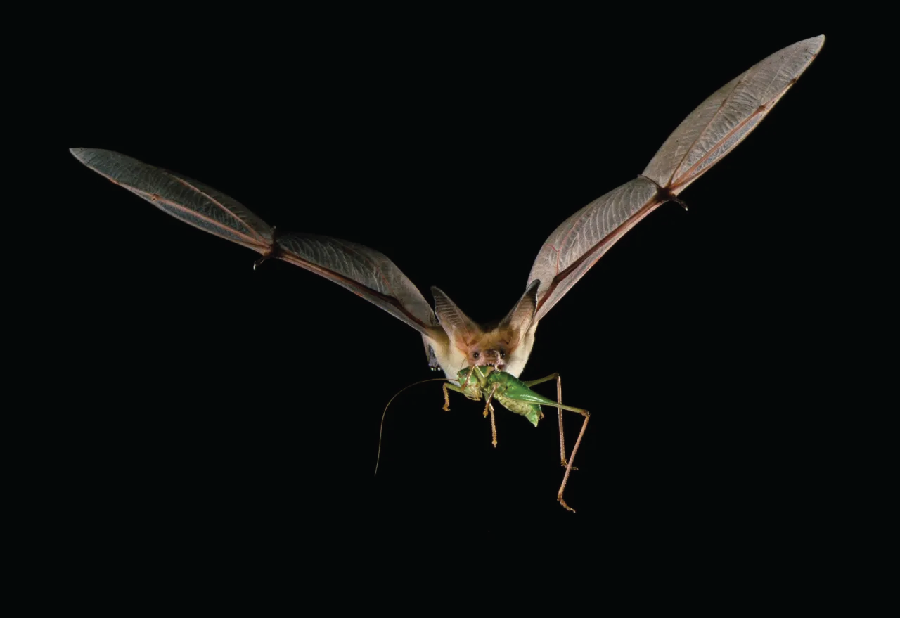Despite a dark reputation, bats are beneficial hunters

A Mexican long-tongued bat (Choeronycteris mexicana) pollinating agave flowers (Agave palmeri) in Arizona. Hundreds of species of agave plants, from the southwestern U.S. to the Caribbean Islands and the Andes Mountains of South America rely on bats as their primary pollinators. (Merlin D. Tuttle)
Voracious insect-eaters are also important pollinators
By Michael Harrelson
(This article originally appeared in the October 17, 2024 edition of the San Diego Union-Tribune)
In many cultures, extending back millennia, bats have been associated with the devil, witchcraft and evil-doers. Their nocturnal activities have spurned countless myths about malevolent behavior: Ancient Judaic texts referred to them as “unclean”; indigenous North Americans considered them tricksters; the Aztecs saw them as symbols of death and destruction; many African tribes feared being attacked and killed by bats if they ventured out at night.
That is an unfortunate reputation for a little creature that plays such an important role in helping to keep our ecosystems balanced. There are over 1,400 species of bats (Chiroptera spp., meaning “hand wing”) in the world. Twenty-three different types of bats make their home in San Diego County. Of the bats found in our area, twenty-one are insectivores and two are nectar-eaters. The largest bat in North America, the western mastiff bat, can be found in our county. When clustered in a cave or dwelling, bats are referred to as a colony. When in flight in large masses, they are called a cloud.
Large numbers of mosquitoes, moths, grasshoppers, crickets, caterpillars, beetles and cockroaches are on the menu for our local bats. It is estimated that bats eat their body weight or more in insects every night, making them a critical element in the control of garden and crop pests.

This pallid bat (Antrozous pallidus) has caught a long-horned grasshopper in West Texas. Bats are a natural insect controller, catchingtheir weight in insects nightly. (Merlin D. Tuttle)
Those that don’t eat insects also play an important part in the life cycle of flowering plants. Like hummingbirds, nectar-loving bats are important pollinators. A wide range of fruits have their pollen moved from flower to flower by these nocturnal, long-tongued visitors. Dragonfruit, peaches, avocadoes, bananas, figs, dates and mangoes are but a few that benefit from this partnership.
In spite of the old adage, bats are not blind. Insectivorous bats rely on echolocation (the bouncing of sound waves that they sense with their large ears) to catch flying insects. In some countries, bats eat fruit, and these bats have large eyes and excellent vision; however, none of these types live in our area.
Bats are not designed to take flight from the ground, and although a healthy bat can do so, they are not good at it. Their strong feet are used for grasping a convenient overhang and, when they want to fly, they simply drop. Bats live much of their lives upside down. They mate and give birth upside down. Being mammals, bats nurse their young pups. When a bat pup is born, the mother catches the youngster as it falls from her womb and encircles it in her wings. Baby bats nurse for about six weeks. Some bats cling to their mother as she takes flight every night in search of food, others stay in the roost.
If a bat is found on the ground, it may or may not be sick. Some bats migrate across long distances, and occasionally one will fatigue and come to the ground or roost in the open where they shouldn’t be. If a bat is out of harm’s way, far from children and pets, let it rest and it will usually fly away. If later the bat is still there, call animal control or the Project Wildlife program, through the San Diego Humane Society, so that a trained professional can remove the bat and have it tested for rabies. Bats do not bite in an aggressive way, only defensively when they feel threatened. Never touch a bat with your bare hands.
Exclusion is the best method of managing bats. Sometimes, however, bats take up residence in a dwelling’s attic. Small bats can squeeze through an opening as small as 1/4 inch. If bats have established a colony where they shouldn’t be, steps must be taken to exclude them. Identify their upper story access by looking for bats exiting. Pay special attention to areas such as vent pipes, chimneys and broken roofing material. Place bird netting over the space and drape it down about a foot. This will allow the bats to push their way out but not be able to get back in. Leave the netting up for about a week, then seal the hole. Sealing the opening before the bats leave will result in the bats dying and creating a different kind of problem. If attempts at exclusion fail, contact a bat removal company.
Bats may take up residence in a barn or outbuilding, and their continued presence is dependent on the level of tolerance a homeowner has for sharing that space. Under no circumstances should bats be allowed to live inside homes or public areas. Although diseases from bat guano are rare, avoid places where bat droppings or urine has accumulated. Bat boxes, erected by homeowners who want the insect-eating benefit of having bats around, should be placed far away from any dwelling and places where people congregate.
Bats and humans can live in harmony. We need them, and they need us to protect them. As Halloween approaches, have fun with decorative toy bats. As for the real bats, living in their natural habitat, admire them, appreciate them and give them plenty of space.
Harrelson has been a UCCE Master Gardener of San Diego County since 2012.

